They say… 
Best beer and travel writing award 2015, 2011 -- British Guild of Beer Writers Awards
Accredited Beer Sommelier
Writer of "Probably the best book about beer in London" - Londonist
"A necessity if you're a beer geek travelling to London town" - Beer Advocate
"A joy to read" - Roger Protz
"Very authoritative" - Tim Webb.
"One of the top beer writers in the UK" - Mark Dredge.
"A beer guru" - Popbitch.

|
A shorter version of this review was first published in BEER August 2009 as part of a piece about beers for summer outdoor drinking, featuring this beer under its rebadged Norfolk Bitter label for Marks and Spencer. For more summer beers, see previous post.
The beer also featured in BEER May 2011 as part of a piece on the influence of different malts on beer flavour. For more about malts in beer, see Itchen Valley Pure Gold.
ABV: 4.5%
Origin: Woodbastwick, Norfolk, England
Website: www.woodfordes.co.uk
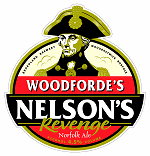 Woodforde's Nelson's Revenge Woodforde’s are a reliable supplier of both cask and bottle conditioned ales so it was no surprise they were one of the breweries chain retailer Marks & Spencer approached when it decided to launch a range of own-brand real ales in a bottle. Woodforde’s contribution is a classic recipe brewed with Maris Otter malt and whole flower hops, in fact a rebadged version of the brewery’s Nelson’s Revenge.
This rubyish red-brown beer has a persistent smooth yellowish head and a lovely spicy glycerine, flower and hop resin aroma, with a slightly syrupy peachy malt palate conveying an earthy bitter dryness over chaffy malt and nuts. A refreshing swallow leads to a drying, nutty and slightly woody finish with rich autumn fruit. A tasty, complex and subtle beer, my favourite in the range.
Added May 2011: Traditionally one of the more popular speciality malts in British brewing is crystal malt, containing extra sugars and kilned at higher temperatures to achieve the “non-enzymic browning” associated with caramel flavours. Woodforde’s Nelson’s Revenge (4.5 per cent) from Woodbastwick in Norfolk has a tasty combination of pale and crystal malts, giving a rubyish mid-brown colour with a chaffy, nutty and fruity, almost peachy, malt character nicely offset by bitterish whole Goldings hops.
To download BEER if you’re a CAMRA member, see http://www.camra.org.uk/page.aspx?o=beer.
To find out more about CAMRA membership, see http://www.camra.org.uk/page.aspx?o=joinus.
For more summer drinking beers see next post.
For more notes on the use of malts in beer, see Vale Black Swan.
Read more about this beer at ratebeer.com: http://www.ratebeer.com/beer/woodfordes-marks-spencer-norfolk-bitter/18803/
A shorter version of this review was first published in BEER August 2008 as part of a piece about beers for summer outdoor drinking. For more summer beers, see previous post.
ABV: 4.2%
Origin: Downton, Wiltshire, England
Website: www.hopback.co.uk
 Hop Back Brewery From this Wiltshire micro’s well distributed portfolio of bottle conditioned beers comes this wheat beer brewed to drink with Thai food, launched in 1999. Two spices common in Thai cuisine, lemongrass and coriander, are added to a grist of Optic pale malt, wheat malt, East Kent Goldings and Pioneer hops.
It’s golden with a thick white head and a fizzy, fruity, hoppy and lightly citric wheaty and yeasty aroma. The crisp palate has developing orangey fruit and spicy coriander, with bitter, twiggy flavours emerging. A dry, slightly herby, lightly bitter finish has vanilla notes. It’s a light, rather understated beer, oddly reminiscent of Kölsch but rather harsher and obviously more herby, and a good choice for spicy food.
More summer drinking beers in next post.
Read more about this beer at ratebeer.com: http://www.ratebeer.com/beer/hop-back-taiphoon/12464/
A shorter version of this review was first published in BEER August 2008 as part of a piece about beers for summer outdoor drinking.
ABV: 4%
Origin: Tyndyrn, Sir Fynwy, Cymru
Website: www.meadowfarm.org.uk, www.kingstonebrewery.co.uk
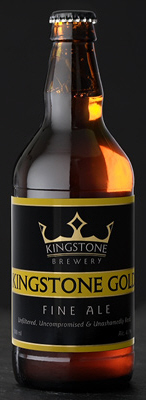 Kingstone Gold Originally established in 2005 at Kinsons Farm, Gwenffrwd (Whitebrook) nearby, this small brewery moved two years later to an idyllic site on the wooded slopes of the Wye valley, not far from the ruins of Tintern abbey and within near-spitting distance of England on the other side of the river. Here it’s part of the Meadow Farm complex including a beer shop stocking not only the brewery’s products but a wide range of other Welsh craft beers.
Gold, formerly known as Kinsons Gold after its original home, is an accessible easy drinking golden ale, made using First Gold and Fuggles hops as well as a touch of wheat malt. It’s a deep amber gold, with a bubbly thick off-white head and a grassy hops and banana yeast aroma. The slightly oily and bubbly light malt plaate has gritty citrus and more banana notes, with firm marmalade leading to a tangy, fruity, slightly gingery finish topped off by grassy hops and puckering zest.
I found the standard version a little too heavy for the style, but the organic version, made with English barley, wheat and First Gold, and Fuggles hops grown in Belgium, is a notable improvement. It’s a slightly lighter colour, with a fluffy foamy white head, less banana and more rose on the grassy aroma. The palate is drier and crisper with a subtle strawberry note. A sharp, spicy bitter note comes to dominate, with the beer finishing resiny dry and lingering with earthy and thistly hops. A decent beer for summer quaffing, particularly to tempt lager-drinking guests.
More summer drinking beers in next post.
Read more about these beers at ratebeer.com: http://www.ratebeer.com/beer/kingstone-kinsons-gold/67145/
First published in BEER July 2008 as part of a piece on beers recently converted to bottle conditioning. For more similar beers see previous post.
Top Tastings 2008. A shorter version appeared on facebook January 2009.
ABV: 4.8 per cent
Origin: Hook Norton, Oxfordshire
Website www.hooknortonbrewery.co.uk
 Hook Norton Double Stout A steam-driven Victorian tower brewery on the edge of the Cotswolds still owned by descendants of the man who founded it in 1849, Hook Norton is one of our remaining treasured independents and a source of excellent cask beers like Old Hooky. Double Stout is also much appreciated as a fine example of a traditional dry stout that can claim a history almost as old as the brewery itself, although it took an extended rest from the portfolio for most of the 20th century before being relaunched in 1996. It now appears on cask as a winter seasonal and has been available all year round in a filtered bottled version which was already pleasant enough. I almost yelped with excitement when I heard this was being replaced by a bottle conditioned version.
A grist of Maris Otter pale, mild, brown and black malts, sugar and Challenger, Fuggles and Goldings hops creates a near-black beer at a relatively modest gravity – as in Belgium, the term “double” doesn’t mean twice the alcohol but reflects the old practice of marking a certain number of crosses on a cask to indicate strength. A rich, straightforward malt and roast aroma has chocolate and slight spice notes.
On the palate the beer is smooth, malty and chocolatey with a pleasant light sparkle, with autumn fruit and acidity emerging over a slick of roast malt with mineral and lead pencil flavours. It turns lightly spicy on the swallow, with a roast coffee finish giving way to chewy, tangy fruit and late blackcurrant and liquorice. You’ll certainly taste the roast, but an exquisite smoothness ensures this remains a drinkable, refreshing bottleful. A minor world classic.
NOTE: This was the last review I wrote for the monthly tabloid BEER. From August 2008, the title became a quarterly in glossy magazine format, and my column changed to including five much briefer reviews on a theme.
Read more about this beer at ratebeer.com: http://www.ratebeer.com/beer/hook-norton-double-stout-cask-bottle-conditioned/44769/
First published in BEER July 2008 as part of a piece on beers recently converted to bottle conditioning. Young’s Bitter also included in Top Tastings 2008.
ABV: 4.5 and 4.8 per cent
Origin: Bedford, Bedfordshire
Website www.wellsandyoungs.co.uk
 Wells and Young's Young's Bitter When you consider how perilously close British bottle conditioned beer was to extinction a couple of decades or so ago, its resurgence today seems miraculous. The Good Bottled Beer Guide, in which my fellow BEER contributor Jeff Evans aims to provide comprehensive listings of Real Ale in a Bottle, gets fatter with every edition and now lists many hundreds of beers.
Nearly all of these, however, are new launches, the vast majority from new generation small breweries. Few traditional independents offer bottle conditioned beers, and very rarely have brewers been brave enough to take established brands that were previously filtered and/or pasteurised and convert (or restore) them to real versions.
We should be more than usually gladdened, then, to hear that over the past couple of months not one, but two, well-established and already well-rated bottled brands from historic breweries have been relaunched as Real Ale in a Bottle. First came the news that Wells and Young’s was expanding its RAIB portfolio, including converting Young’s Bitter to bottle conditioning. Then Hook Norton announced the bottled version of its classic Double Stout was going live.
These moves follow on from modest but notable increases in support by supermarkets looking to position bottle conditioned beers as a premium product, suggesting the old excuse that “customers don’t like sediment” is becoming increasingly less relevant. Let’s hope that other big supermarket speciality names like Badger, Batemans, Harviestoun, Marstons/Wychwood and Robinsons are taking heed.
Wells and Young’s might now be one of our “new nationals” but I’m impressed with how well Young’s rich legacy is being looked after in Bedford. London real ale drinkers were traditionally expected to offer their loyalty to either Fullers or Young’s – but while London Pride remains the taste of my formative years, I’ve discovered there’s much to be said for the quenching and curiously astringent delights of Ordinary, as Young’s Bitter on draught is known to its aficionados. That character was well preserved in the move from Wandsworth to Bedford, and now the bottled version – long brewed at a more robust gravity than the draught – has gone real, an appropriate compliment to a beer already so rich in heritage.
It’s a pale copper coloured ale made with a traditional grist of Maris Otter pale malt, Fuggles and Goldings hops – the first from a major British brewer to carry the Red Tractor award guaranteeing quality assured production. It pours with a fine white head and an aroma very much like the draught version – sweetish, malty and slightly sour and sulphurous. A firm, tasty barley sugar palate also has a dash of characteristic acidity, with crisp but restrained hops and faint, subtle orange.
 Wells and Young's Young's Kew Gold A moreish, lightly bitter finish offers subtle citric flavours before developing quite peppery hop notes, but overall subtler and noticeably fresher than the previous pasteurised interpetation. It’s a taste experience comparable to sinking a well-kept pint of Ordinary in a pub, and I can’t think of a higher compliment.
Kew Gold is the second beer to emerge from the brewery’s partnership with the Royal Botanic Gardens, Kew, a little way up the Thames from its former Wandsworth site. Rare hops are grown in the Gardens and small amounts have been used at the brewery, but production is limited so this beer is “inspired” by Kew hops – instead Styrian Goldings are matched for flavour, with a grist of lager malt and a small amount of crystal, and a proportion of the proceeds goes to Kew.
This is a rich deep gold beer with a fine white head and grassy lager-like hops in the aroma. A full-bodied slightly syrupy palate has lime citrus notes and a layer of resinous hops from the start, with fresh cereal notes and fruit. A controlled peppery bitterness develops alongside more malt and fruit in a slightly gingery finish. It’s a pleasantly hoppy, quaffable but characterful beer and a good entry level Real Ale in a Bottle for the premium lager drinker.
For more beers recently converted to bottle conditioning, see next post.
Read more about these beers at ratebeer.com:
http://www.ratebeer.com/beer/youngs-bitter-bottle-conditioned–45/104149/
http://www.ratebeer.com/beer/youngs-kew-gold-bottle/86957/
Top Tastings 2010 (Verdi Black Jack)
ABV: 5%, 8.2% and 8%
Origin: Roncole Verdi, Emilia-Romagna, Italy
Website: www.birrificiodelducato.com
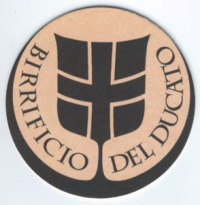 Italy, as I’ve mentioned here before, is currently one of the beer world’s innovation hotspots, with an emerging craft brewing movement fusing native respect for fine food and drink with a creative energy partly inspired by US brewing, and similarly unhindered by a distinctive national brewing tradition. Sadly few of the results of this have so far found their way to Britain. So I was delighted to find myself at a rare tasting of Italian beers, mainly from Birrificio del Ducato, at London’s Rake pub, thanks to a last minute invitation from tasting tutor and Ducato brewer Matteo Milan, who as a former brewer at Scotland’s BrewDog, is still maintaining his British connections. Italy, as I’ve mentioned here before, is currently one of the beer world’s innovation hotspots, with an emerging craft brewing movement fusing native respect for fine food and drink with a creative energy partly inspired by US brewing, and similarly unhindered by a distinctive national brewing tradition. Sadly few of the results of this have so far found their way to Britain. So I was delighted to find myself at a rare tasting of Italian beers, mainly from Birrificio del Ducato, at London’s Rake pub, thanks to a last minute invitation from tasting tutor and Ducato brewer Matteo Milan, who as a former brewer at Scotland’s BrewDog, is still maintaining his British connections.
Ducato’s style is less edgy than BrewDog’s, but the Italian brewer is if anything more willing to push the envelope, with high gravities, blending, souring with wild yeast, wood ageing and a fresh approach to spicing all key components of the brewing toolkit. Starting production in 2007 in the small village of Roncole Verdi near Parma, a household name in Italy as the birthplace of opera colossus Giuseppe Verdi, the brewery has quickly gone on to win awards under head brewer and co-founder Giovanni Campari, formerly of one of the older-established Italian craft brewers Birrificio Italiano. It might be a fanciful comparison, but some of Ducato’s bigger beers are composed on a dramatic and ambitious scale that might be called operatic.
Matteo brought a wide range of the brewery’s beers, both regular and special brews, and I was highly impressed with almost all of them — it was hard to select only three to feature here, but they do demonstrate Ducato’s range.
 Viæmilia is the brewery’s first beer, its biggest seller and its most suitable offering for easy everyday drinking. “Dedicata alla nostra terra,” it’s named after the old Roman road, the Via Æmilia, which passed nearby on its way from Piacenza to Rimini — the road itself had got is name from the consul that oversaw its completion, and such was its fame that it ended up giving its name to the region through which it passed, still known as Emilia today. The award winning beer is an unpasteurised and properly lagered premium pils-style that in most respects is ultra-authentic, to the extent that the Tettnanger hops is sourced from a small producer in Tettnang itself, necessitating occasional trips to Baden-Württemberg. One important departure from authenticity is the extra addition of whole hops after the primary fermentation, the British-style “dry hopping” technique that’s otherwise completely unknown in traditional lager brewing. Viæmilia is the brewery’s first beer, its biggest seller and its most suitable offering for easy everyday drinking. “Dedicata alla nostra terra,” it’s named after the old Roman road, the Via Æmilia, which passed nearby on its way from Piacenza to Rimini — the road itself had got is name from the consul that oversaw its completion, and such was its fame that it ended up giving its name to the region through which it passed, still known as Emilia today. The award winning beer is an unpasteurised and properly lagered premium pils-style that in most respects is ultra-authentic, to the extent that the Tettnanger hops is sourced from a small producer in Tettnang itself, necessitating occasional trips to Baden-Württemberg. One important departure from authenticity is the extra addition of whole hops after the primary fermentation, the British-style “dry hopping” technique that’s otherwise completely unknown in traditional lager brewing.
The beer is a hazy very pale yellow with a fine fluffy white head. The dry hopping immediately shows itself in the fresh, big and grassy, lightly fruity and resinous aroma, underlined by delicate and slightly honeyed malt. The palate is a wonderful combination of spicy, floral and rather piny hops and chaffy, foamy and lightly grainy soft malt, leading to a notably peppery finish with exotic spices wafting into the nose. The hops are still kept down to earth, though, by decent, slightly bready and floury malt, so the bitterness isn’t overwhelming. Overall it’s a delightfully moreish and refreshing brew.
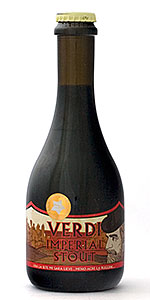 Birrificio del Ducato Verdi Imperial Stout At the other end of the spectrum in terms of colour and strength is Verdi Imperial Stout, its name honouring Roncole’s most famous son, and once again this is a classic and authentic recipe with a stylish twist. Bottled unfiltered and unpasteurised but with no repriming of yeast, this beer is a still, thick black that leaves a brown iodine-like wash on the sides of the glass as it swirls. The aroma is full of dark marmitey malt, coffee, chocolate and liquorice. The relatively thin and winy palate is fully malty, chocolatey and liquoricey with a big roast bite, but then comes the surprise — the gently mouth-numbing warmth it generates in the mouth is not so much from the alcohol as from some studiously blended chilli.
The balance is just right — not so much as to overwhelm the more traditional spicy and roast notes that emerge in a very long finish, which turns sappy, drying and slightly woody. The beer deservedly became the first and so far only Italian craft brew to win a gold medal in its style at an international beer competition when it was named best imperial stout at the European Beer Star in 2008.
It’s also available in a wonderfully mellowed version aged for six months in bourbon casks under the name Verdi Black Jack. This is black with a good yellowy-brown head, a slightly brett-tinged smooth vanilla, coconut and whisky aroma and a very complex dark malt and chocolate palate with a sweet touch, leahter and whisky hints and the tang of wild yeast. A chocolatey finish has rummy spirit and wine notes and layers of bitterness and honey sweetness. Age has mellowed the chilli heat but it’s still present in a stunningly complex blend of flavours.
Even more of an unusual speciality is La Luna Rossa (“the red moon”), an offbeat reworking of a Belgian sour brown ale-based kriek. It’s a blend of three different beers of different ages matured in wine casks with the aid of wild yeast and a quantity of fresh local marasca cherries, a variety of sour morello cherry classically used to make Maraschino liqueur. This is also bottled more or less still and emerges a deep amber colour, with notes of fruit, almonds, balsamic vinegar and the distinctive tang of brettanomyces yeasts on the aroma.
A sappy woody palate has sweet and sour sauce notes and emerging cherry fruit, an irony Rodenbach-like touch but also obvious shades of lambic-type kriek. The long and slightly sticky finish is amazingly complex, with more wood, vanilla, balsamic and cherry skin notes, a touch of salt, walnuts and wafer biscuits. A breathtaking demonstration of what beer is capable of in the hands of a skilful and inspired brewer.
Read more about these beers at ratebeer.com:
http://www.ratebeer.com/beer/birrificio-del-ducato-viaemilia-via-emilia/79805/
http://www.ratebeer.com/beer/birrificio-del-ducato-verdi-imperial-stout/84864/
http://www.ratebeer.com/beer/birrificio-del-ducato-verdi-black-jack/124259/
http://www.ratebeer.com/beer/birrificio-del-ducato-la-luna-rossa/124170/
First published in BEER June 2008 as part of a piece about wheat beers. Read more about wheat beers in previous post.
ABV: 3.1 and 5.4 per cent
Origin: Kulmbach, Franconia (Bavaria), Germany
Website www.kulmbacher.de
 Kulmbacher Kapuziner Weißbier Leicht  Kulmbacher Kapuziner Weißbier mit feiner Hefe Bavaria is, of course, one of the heartlands of wheat beer brewing and about the only part of the world where brewers didn’t suffer collective amnesia over the use of wheat at some point in the last fifty years. Within Bavaria, it doesn’t get more beery than Franconia, where in the town of Kulmbach you’ll find one of the region’s biggest craft breweries, simply named Kulmbacher, the result of a merger of four local breweries in 1996.
Kulmbacher’s wheat beer range, produced under the monastic moniker Kapuziner, is now being imported into the UK. It includes a standard unfiltered pale wheat beer as well as a lower gravity “leicht” (light) – this being Bavaria, both are made with the pure ingredients of malted barley, malted wheat, hops and water only.
At 3.1 per cent the leicht is as strong as some British standard bitters but is certainly light for the style. It pours an authentic sunny orange-yellow with a thick white rocky head and a characteristically spicy aroma, with grainy and hay meadow scents and a hint of banana. There are cereal notes on a slightly oily palate with a pronounced lemon citrus flavour, turning orangey on a smooth tangy finish. Overall it’s a tasty beer but slightly thin.
The standard cloudy wheat beer is a weightier offering, similar in appearance but with a more complex aroma featuring clear strawberry and banana notes and a touch of farmyard – the distinctive wheat beer yeasts have obviously had a busier time with more gravity to work with. More banana fruit joins rich toffee on a firm, slightly sweet palate, and there are more hops too on a long chewy citric finish.
Read more about these beers at ratebeer.com:
http://www.ratebeer.com/beer/kapuziner-weissbier/5093/
http://www.ratebeer.com/beer/kapuziner-weissbier-leicht/14763/
First published in BEER June 2008 as part of a piece about wheat beers. Read more about wheat beers in previous post.
ABV: 4.4 per cent
Origin: Kewaigue, Isle of Man
Website www.okells.co.uk
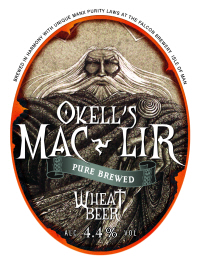 Okell's Mac Lir Wheat Beer From one of the other Celtic nations [Cornwall was featured in the last post] comes a wheat beer at a more quaffable strength. The Isle of Man’s biggest brewery and its only surviving Victorian-era independent, Okells was founded in 1875, though moved to its current site just outside Douglas in 1994. Long known as a bastion of traditional styles on an island renowned for its conservatism, the brewery has in recent years diversified into new specialities to reach markets across and beyond the Irish Sea, under the inspired guiding hand of its Yorkshire-born head brewer, eccentrically moustachioed Dr Mike Cowbourne.
In the process it’s made much of its Celtic heritage: witness unfiltered wheat beer Mac Lir, named after a legendary warrior wizard and sporting label artwork that appears inspired by 2000AD’s Sláine strip. However the launch of this beer occasioned a significant break from tradition. Brewing on Man is regulated by a Bavarian-style purity law that limits ingredients to barley malt, hops, sugar and water, so before they could produce a wheat beer, the brewery faced a six-month wait while the Manx parliament, the Tynwald, considered their application for an exemption.
We can be thankful this was finally approved since the beer is very good indeed. Made with a half-in-half grist of Maris Otter barley malt and malted wheat, it’s a hazy orange-yellow beer with a good white head, and flowery citrus and botanical notes on a creamy wheat aroma. The rich spicy palate is quite well hopped but beautifully balanced with cereal and citrus tones, and a cleansing swallow leads to a chewy tasty finish with a faint hint of roast and burnt wood. There’s a notable hoppiness (seven varieties are used at different stages of the boil) to this big, distinctive and wheaty beer which is one of the best examples of the style I’ve tasted from the British Isles.
Read more about wheat beers in the next post.
Read more about this beer at ratebeer.com: http://www.ratebeer.com/beer/okells-maclir-bottled/19364/
First published in BEER June 2008 as part of a piece about wheat beers.
ABV: 6.8 per cent
Origin: Rock, Cornwall, England
Website www.sharpsbrewery.co.uk
 Sharp's Honey Spice Wheat Beer It’s a fine sunny spring day outside as I write this page – perhaps, given the weather so far this year, it’s too much of a leap of faith to assume the days will be warmer still by the time you read it. But even under grey skies you might cheer up by cracking open a bottle of wheat beer. With their buttercup and straw colours, summery fruit flavours and aromas as heady as a wildflower meadow on a hot day in June, they’re the perfect warm weather drink.
Cornwall’s Sharp’s has made waves from its coastal site since 1994 with cask bitter Doom Bar. But dynamic and imaginative head brewer Stuart Howe also has ambitions to brew world class speciality bottled beers that can hold their own against fine wine on the dining table. First he gave us Chalky’s Bike, flavoured with Cornish fennel (BEER, November 2007), and now he’s launching three more bottle conditioned specialities: abbey beer St Enodoc Double, 10 per cent barley wine Massive Ale, and this intriguing strong spiced wheat beer.
Hopped with Goldings and Bobek, enriched with Cornish honey and spiced with cinnamon, coriander and mixed peel, Honey Spice arrives in an elegant 660ml bottle intended for sharing at table, perhaps over a salad, seafood or white fish dish as recommended on the label. Leave it to settle for a clear beer, or do as I did and drink hazy, pouring a rich golden colour with a thick white orange-tinged head.
A spicy aroma has a fresh creamy cereal note and a barely detectable hint of coriander. The palate is firm but subtle, dry and herby, with a delicate, slightly leafy bitterness and a touch of marzipan, with identifiable coriander and earthy cinnamon starting to emerge. A slightly peachy swallow leads to a dry, spicy finish with delicate hops and herbs, a light citrus touch and a hint of old books.
Overall this is a very well-made, distinctive and refreshing beer with a remarkably light touch considering the relatively hefty strength – on a sunny day it would be tempting, though certainly not advisable, to swig with abandon. Beers like these should put Sharp’s in the first rank of modern British brewers.
Read more about wheat beers in the next post.
Read more about this beer at ratebeer.com: http://www.ratebeer.com/beer/sharps-honey-spice-wheat-beer/88623/
First published in BEER May 2008 as part of a piece about Norfolk milds. More Norfolk milds in previous post.
ABV: 3.9 per cent
Origin: Heacham
Website: www.foxbrewery.co.uk
 Fox Nina's Mild A more traditional example of vertical integration [than with Uncle Stuart’s in the previous post] can be found at Heacham, a village on the Wash in northwest Norfolk which is also famous for its lavender. Here the Fox Brewery has been supplying ales to the Fox and Hounds pub since 2002, when the new owners of the pub found a new use for an empty outbuilding, though its large and varied bottled range is also available more widely.
Nina’s Mild is made from Maris Otter pale, crystal and toasted malt from the celebrated Branthill Farm, a little way east along the coast. It’s a dark red-brown beer with a thick and rocky fawn head, and a malty, gently roasty and spicy aroma with black coffee hints.
A slightly thin palate has plenty of chocolate and fruit, with more pronounced, but not overbearing, smoky and roasty notes on the finish. The smokiness is a reminder of what rustic English beer might have tasted like in the days before modern malting, when brown malt kilned over wood or straw was the principle brewing grain. Late fruit and chocolate notes tail an interesting beer which remains easily quaffable despite the intensity of its flavours.
Read more about this beer at ratebeer.com: http://www.ratebeer.com/beer/fox-ninas-mild/51826/
|
Cask  This pioneering new book explains what makes cask beer so special, and explores its past, present and future. Order now from CAMRA Books. Read more here. This pioneering new book explains what makes cask beer so special, and explores its past, present and future. Order now from CAMRA Books. Read more here.
London’s Best Beer  The fully updated 3rd edition of my essential award-winning guide to London’s vibrant beer scene is available now from CAMRA Books. Read more here. The fully updated 3rd edition of my essential award-winning guide to London’s vibrant beer scene is available now from CAMRA Books. Read more here.
|


















